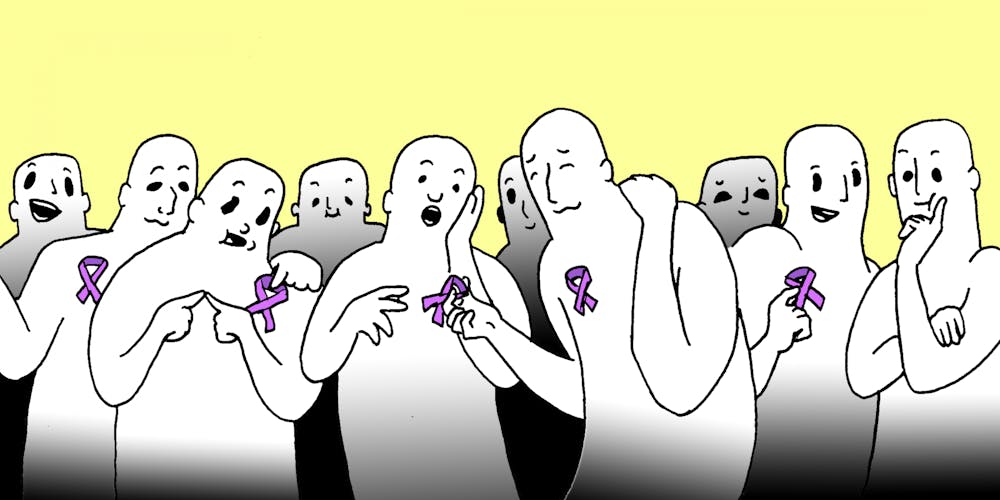National Epilepsy Awareness Month is normally celebrated with walks, programs and purple ribbons during the month of November. However, because of the COVID-19 pandemic, many events became virtual or did not happen at all.
Epilepsy is a condition which causes a person’s brain to have seizures. According to the National Epilepsy Foundation website, one in 26 people will develop epilepsy at some point in their life, meaning roughly 3.4 million people in the United States have epilepsy.
There are many misconceptions about epilepsy, said Alyssa Edwards, program coordinator at Epilepsy Foundation Indiana. Among these are that epilepsy is contagious, which it is not, or thinking they should restrain someone who is having a seizure, which can actually cause more harm.
Edwards said Epilepsy Foundation Indiana tries to educate people on what epilepsy is and give people the necessary information to help someone having seizures. But due to the pandemic, many of their events this year had been canceled.
There is a difference between having seizures and having epilepsy, Edwards said. Everyone has a threshold for seizures, meaning someone with a lower threshold can have a seizure just by having a high fever, for example.
“Even if they seem like they’ve come back to normal you want to make sure that they are 100 percent aware of what’s going on because after a seizure someone can be very disoriented and confused. So stay with them,” Edwards said.
In a normal year the organization would have five different Walk to End Epilepsy events in various cities across Indiana. However, this year, they were only able to have a walk in Evansville, Indiana, in May and in Indianapolis in September and both were virtual, Edwards said.
During November, Epilepsy Foundation Indiana would normally have an annual Epilepsy and Seizure Wellness Expo which would include a day of sessions covering various topics relating to epilepsy and seizures such as insurance or CBD treatments, Edwards said. This November, the virtual version did not have the registration numbers they were hoping for so they are planning to try again in early 2021.
Edwards said they focused this month on raising awareness about the diagnosis, what it means to have epilepsy and helping people who have the condition know that they are not alone.
“Someone that has epilepsy and seizures, you’re not going to know that they are struggling with that condition unless you see them have a seizure,” Edwards said.
The Epilepsy Foundation of Indiana tries to raise awareness about proper first aid for someone who is having a seizure, which involves turning them on their side if they have collapsed and are unconscious but do not try to restrain them in any way or put anything in their mouth.
They offer training to a wide range of people, including law enforcement and people who work in schools. They are also able to rework their training for any group that has requested it.
“We always tell people to cater your seizure first aid to whatever situation you’re in but generally you’ll want to do ‘Stay, Safe, Side,'” Edwards said.
The “Stay, Safe, Side” process means one should not leave a person alone when they are having a seizure, turn them on one of their sides if they are unconscious and keeping a person safe if they are having seizure that has not caused them to fall to the ground but has made them unaware of their surroundings.
Dr. Robert Blake, an epileptologist with Riley Hospital for Children, said there are many different kinds of seizures and different kinds of epilepsy itself.
Epilepsy can be caused by brain injuries, brain tumors, genetics or a malformation of the brain, Blake said. The multiple potential causes of seizures means there is a lot of variability between each patient. For example, some people are diagnosed as children and outgrow the condition, while other people do not begin having seizures until adulthood.
“About half the cases of epilepsy have an unknown cause,” Blake said. “Meaning even when we look at all of our tests, we still don’t know why that person has seizures.”
Blake said seizure medicines are the main form of treatment but they only work for about 60-70 percent of patients. Some patients are able to control their seizures with dietary therapy such as switching to the ketogenic diet or variations of it. In some cases, surgery is also an option.
“Indiana University Health, including Riley Hospital for Children, is the only level four epilepsy center in the state of Indiana,” Blake said. “So we are the only center that is able to offer all the different treatment options for children with epilepsy.”
Patients may need to be cautious with activities such as swimming, riding bikes or climbing to high places because these could become dangerous situations if the person were to have a seizure. However, once the seizures are being controlled by a treatment, they can have a normal life, Blake said.
“The good news is, many kids with epilepsy can get their seizures controlled in which case they would be allowed to do normal activities such as driving and working, ” Blake said.






